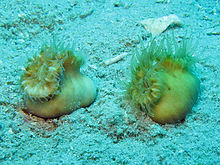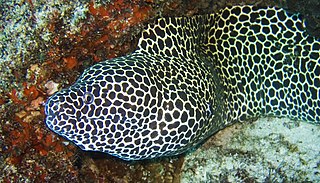
The laced moray, also known as the leopard moray, tessellate moray or honeycomb moray, is a species of marine fish in the family Muraenidae.
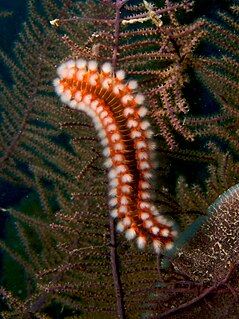
Hermodice carunculata, the bearded fireworm, is a type of marine bristleworm belonging to the Amphinomidae family, native to the tropical Atlantic Ocean and the Mediterranean Sea.
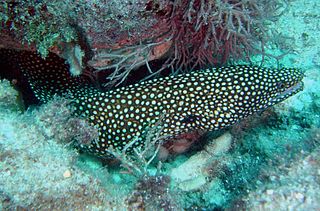
The turkey moray ,also known as the guineafowl moray or as the white-mouth/whitemouth moray is a species of marine fish in the family Muraenidae.

Aluterus scriptus, commonly known as scrawled filefish, broomtail filefish or scribbled leatherjacket, is a marine fish belonging to the family Monacanthidae.

The checkerboard wrasse is a fish belonging to the wrasse family. It is native to the area including the Indian Ocean to central Pacific Ocean.
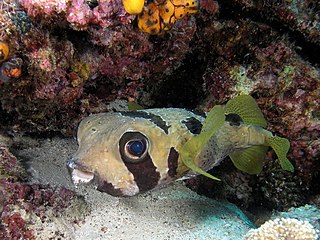
The black-blotched porcupinefish, also known as shortspine porcupinefish, is a member of the family Diodontidae. It is found in the tropical and subtropical waters of the Indo-Pacific on coral and rocky reefs and in inshore waters. Other names are the blotched porcupinefish and the brown-backed porcupinefish.

The spot-fin porcupinefish, also known as the spotted porcupinefish, black-spotted porcupinefish or simply porcupinefish, is a member of the family Diodontidae.

Botrylloides leachii is a colonial tunicate of the family Styelidae. Its unique methods of propagation and regeneration make it an ideal model organism for use in biological study of development, immunology, stem cells, and regeneration.
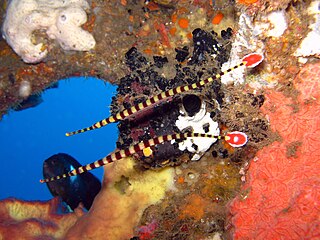
The banded pipefish or ringed pipefish is a species of fish in the Syngnathidae family.
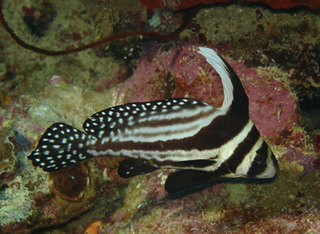
The spotted drum or spotted ribbonfish, is a species of marine fish in the family Sciaenidae.
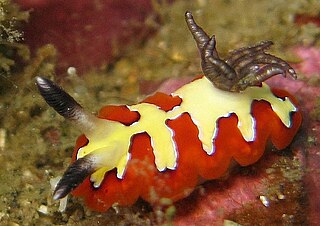
Goniobranchus fidelis, also commonly known as the faithful sea slug, is a species of colourful sea slug, a dorid nudibranch, a marine gastropod mollusc in the family Chromodorididae.

The barred-fin moray or bar-tail moray is a species of marine fish in the family Muraenidae.

Phenacovolva rosea, also known as the rosy spindle cowry, is a species of sea snail, a marine gastropod mollusc in the family Ovulidae, the ovulids, cowry allies or false cowries. It lives and feeds on fan, whip and bush-type gorgonians.

Galaxea fascicularis is a species of colonial stony coral in the family Euphylliidae, commonly known as octopus coral, fluorescence grass coral, galaxy coral among various vernacular names.

The yellowhead wrasse is a fish species belonging to wrasse family native to shallow tropical waters in the Caribbean Sea and western Atlantic Ocean.

Arothron caeruleopunctatus, also known as the blue-spotted pufferfish, is a demersal marine fish belonging to the family Tetraodontidae.
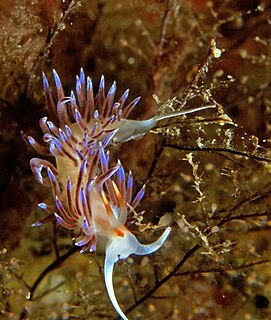
Cratena peregrina, commonly called the pilgrim hervia, is a species of sea slug, an aeolid nudibranch, a marine gastropod mollusc in the family Facelinidae.

Aspidosiphon muelleri is a species of unsegmented benthic marine worm in the phylum Sipuncula, the peanut worms. This worm is found in the eastern Atlantic Ocean, the Mediterranean Sea and in various locations in the Indo-Pacific region at depths down to about 1,000 m (3,300 ft).

Heterocyathus aequicostatus is a small species of coral in the family Caryophylliidae in the order Scleractinia, the stony corals. It is native to the Indo-Pacific region. It is a large polyp, solitary, free-living coral and is usually found on soft substrates.

Heteropsammia is a genus of apozooxanthellate corals that belong to the family Dendrophylliidae.
